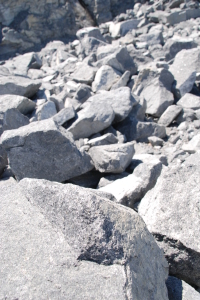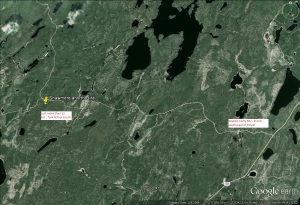Next Lunar Mission – Moon Rocks and Northern Ontario
by Back Roads Bill
 We know the moon is not made of Swiss cheese. Neil Armstrong proved that on July 21, 1969 during the Apollo 11 mission. We tend to remember the event or the person more than the date.
We know the moon is not made of Swiss cheese. Neil Armstrong proved that on July 21, 1969 during the Apollo 11 mission. We tend to remember the event or the person more than the date.
Some of you will remember where you were on that day others were not yet “thoughts” or Earthlings. To refresh our memories Armstrong became the first to step onto the lunar surface . He spent about two and a half hours outside the spacecraft, his partner Buzz Aldrin slightly less; and together they collected pounds 21.5 kg (47.5 lb.) of lunar material for return to Earth. During subsequent Apollo surface excursions, 2,415 samples weighing 382 kg (842 lb.) were collected, the majority by Apollo 15, 16, and 17. Those rocks are now important to northern Ontario.
We also know it has taken Sudbury along time to shed its lunar image. During the Apollo exploration program, NASA (North American Space Agency) astronauts trained in Sudbury to become familiar with rare rock formations produced by large meteorite impacts. However, the popular misconception they were visiting the “Nickel City” because it purportedly resembled the lifeless surface of the moon was initiated. In reality it was the geology of northern Ontario that was important and remains so.
Particularly, the Apollo 16 astronauts were the first to visit the Sudbury basin for their mission. They participated in an extensive training program that included several field geology trips to introduce the astronauts to concepts and techniques they would use on the lunar surface. During these trips, the astronauts visited and provided scientific descriptions of geologic features they were likely to encounter. Geologists chose the Sudbury area because of a 97 km (60 miles) wide crater created about 1.6 million years ago by a large meteorite. During the training exercises the astronauts did not wear spacesuits, but carried radio equipment to converse with each other, practicing procedures they would use on the lunar surface.
What’s Next?
Scientists have studied the Moon for centuries, with a lot of conflicting theories. Only actual substrate samples (without the Swiss cheese) could provide precise and accurate answers about compositions, ages, and processes. Another sedge way to northern Ontario as humankind is about to take another “leap” forwards. From the unforgettable Armstrong quote, “That’s one small step for [a] man, one giant leap for mankind.” Neil Armstrong passed away last summer on August 25th at the age of 82.
What is important now? It is anticipated humans will return to the moon by 2020 and the anticipated construction of a permanent lunar base. Those Apollo missions, the lunar training and the geology are once again significant. There are some rocks on a back road that will help with future trips to the moon.
There is a renewed need to understand the lunar surface environment. It is necessary to determine optimal methods for operations in the lunar “regolith” at selected landing sites. Regolith is the unconsolidated, abrasive material blanketing the lunar surface. This is the point of contact for humans and infrastructure. It is unlike any material naturally occurring on Earth.
Melissa Battler told Back Roads Bill, “A majority of the lunar surface is made up of rocks similar to the Shawmere Anorthosite, found near Folyet, Ontario. “ She is a PhD. Research Assistant, at the Centre for Planetary Science and Exploration at the University of Western Ontario. She has utilized these rocks in simulating what will be. The goal of her applied research was to develop a “recipe” for creating a physical/mechanical lunar regolith.
“This type of rock is much less common on the surface of the Earth,” said Ms. Battler. “Therefore, in order to prepare for future lunar missions, it can be helpful to test drilling, construction and excavation equipment using a lunar soil simulant composed mainly of the Shawmere anorthosite, as it will have mechanical properties similar to those that we will experience while operating on the surface of the Moon. “ She said there are very few sources in the world and the Folyet deposit is “definitely a world-class lunar analogue site for chemical/mineralogical accuracy.” The crushed, anorthosite particle size is comparable to the Apollo 16 regolith sample # 64 500 found in the Descartes Highlands.
“NORCAT are continuing some work with the lunar regolith simulant I created, and an additional one. Many other groups including universities across Canada, the Canadian Space Agency and NASA, other Canadian space companies are also using my simulant to prepare for lunar surface missions.” The Sudbury-based Northern Centre for Advanced Technology has been working with NASA on the project since 2004 and has received awards for its research and development. A drill has been developed with a lunar rover built by Carnegie Mellon University’s Robotics group. There is now a contract with the Canadian Space Agency. A trip to the moon once again seems closer.
Anorthosite is a calcium rich feldspar and can also be processed to produce a raw material for the manufacture of reinforcing glass fibre and other industrial products such as mineral fillers. The remote mining claim is owned by Avalon Rare Metals, a Canadian company headquartered in Toronto, Ontario, Canada. Avalon trades on the Toronto Stock Exchange (TSX) and the New York Stock Exchange MKT (NYSE MKT), both under the symbol AVL. It was first discovered by the then Ontario Department of Mines in 1977, now the Ministry of Northern Development and Mines.
Anorthosite is an unusual mafic igneous intrusive rock consisting of greater than 90% plagioclase feldspar. A 417 tonne of pure anorthosite product sample was used in a furnace trial to evaluate its performance as an alternative raw material for certain fibreglass applications offering potential product quality, cost and environmental benefits including reduction of furnace greenhouse gas emissions.
Moon Rock Access
A northosite is an attractive rock, horticulturalists would like it for their gardens. Folyet is south west of Timmins on Highway 101 which connects to Chapleau. The destination is UTM WGS 84 Zone 17 U 366677 5332403 or N48° 07’ 51.3’ W82° 47’ 30.7”. Access is by way of Warren Carty (WC) road, 21 km south west of Folyet, travel west from the junction with Hwy 101 on the forest access road. It is 12 km on the WC road to a branch trail to the south; walk in about 300 metres to the small quarry.
northosite is an attractive rock, horticulturalists would like it for their gardens. Folyet is south west of Timmins on Highway 101 which connects to Chapleau. The destination is UTM WGS 84 Zone 17 U 366677 5332403 or N48° 07’ 51.3’ W82° 47’ 30.7”. Access is by way of Warren Carty (WC) road, 21 km south west of Folyet, travel west from the junction with Hwy 101 on the forest access road. It is 12 km on the WC road to a branch trail to the south; walk in about 300 metres to the small quarry.
During the back road jaunt it was like playing poker. The “lucky” hand, a full house of bears, three of-of-a kind in one bear sighting; two very small cubs with the sow; then a pair of two individual males; on the other hand a pair of moose, two different sightings. Take your whistle and your camera. And the “man in the moon” face; what’s that all about?
For GPX and maps Moon Rocks
